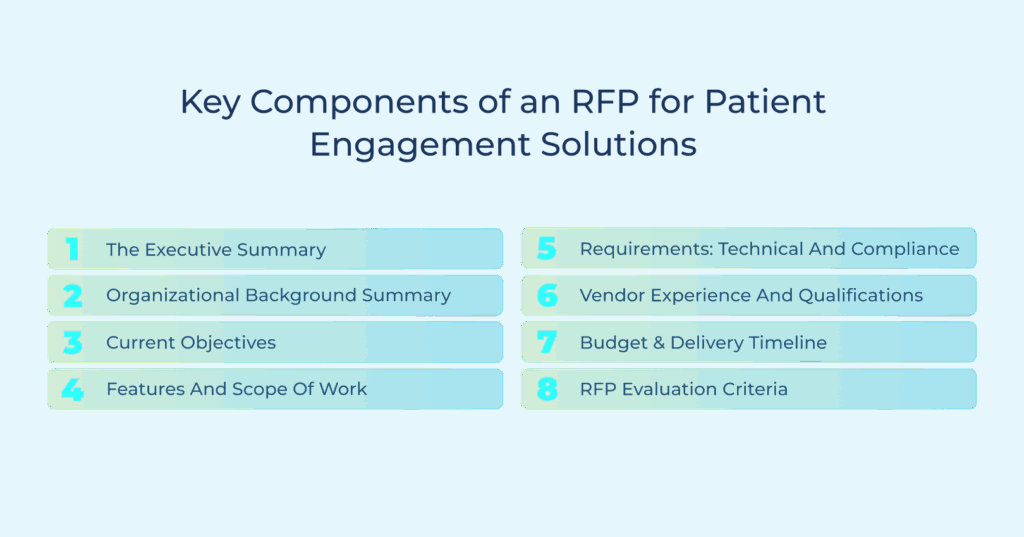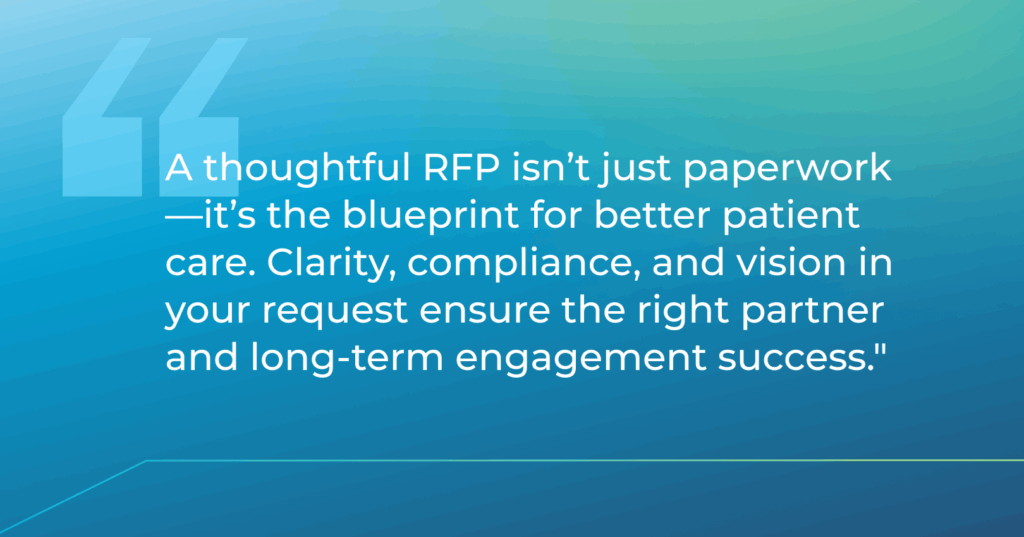Televox is proud to announce that its Enterprise Edition SMS solution has been awarded Gold…

How to Write an RFP for Patient Engagement Software
The wrong patient engagement platform is more disruptive than you think. You can either spend more resources on making the platform work for your team or consider investing in another solution down the road. Either way, it’s a costly mistake.
Your Request for Proposal (RFP) matters here because a well-written one gets the job done right on the first attempt. You’re basically setting the ground rules and giving vendors a clear picture of what you want. It helps separate real solutions from generic sales pitches.
In this guide, we’ll walk you through how to write an RFP that gets clear, useful responses for your healthcare organization.
What’s an RFP in Healthcare?
Think of a Request for Proposal (RFP) as your healthcare organization’s ultimate wishlist, only smarter, more strategic, and built to deliver real results. It’s more of a blueprint than a formal document that spells out exactly what you need, when you need it, and how you expect it to happen.
When it comes to creating RFPs, note that they are not bound by any specific ruleset. They vary from organization to organization, but typically involve long-term goals, technical specifications, and a budget. RFPs are also an evaluation criterion to compare different vendors based on how well they meet your healthcare requirements.
They serve as the foundation for major technology and service decisions that directly impact patient care quality and organizational efficiency. The thoroughness of these documents often determines the success of the eventual implementation.
Healthcare providers commonly use RFPs when they are looking to invest in new technology such as EHR systems, analytics, billing systems, and communication platforms.
The Need for a Strong RFP for Patient Engagement Systems
RFPs are meant for long-term investment, making them incredibly important for when it’s time to choose a patient engagement system. Without a clear RFP, healthcare organizations risk partnering with the wrong vendors who fall short of meeting their requirements.
For instance, a vendor solution that either doesn’t scale well or isn’t user-friendly. The cost of such a mismatch can be steep. Your budget ends up wasted, your staff finds the new system frustrating, and most of all, you collectively start disengaging patients.
Key Components of an RFP for Patient Engagement Solutions

RFPs need to be clear and to the point. They cannot afford any ambiguity because you need your potential vendor to understand straight away what you’re looking for. Include these eight essential components to create a comprehensive request to find the right patient engagement platform.
1. The Executive Summary
Start with a brief overview. It should include your main goals for the patient engagement platform and what results you’re expecting the software to deliver. The overview needs to be short. Most organizations keep it to one page. Hence, focus only on what matters.
2. Organizational Background Summary
In the next step, start describing your healthcare organization. Some important details to include are your location, services offered, current systems, current staff members, and the number of patients dealt daily/monthly on average.
Make sure to mention all your existing EHR systems, communication tools, and any patient engagement solutions you currently use. Additionally, mention any other platforms or integrations that vendors should be aware of, such as billing systems, scheduling software, or data warehouses. This information helps vendors understand your operational environment and technical landscape.
3. Current Objectives
This section needs to be direct as well. Define exactly what you want to achieve with a patient engagement solution. You don’t have to pick just one. List all your objectives to help vendors understand your priorities. For instance, maybe you’re looking to reduce no-shows and administrative workload, along with automating routine communication.
It’s also a good idea to share where you see your organization heading in the next couple of years. What would success look like 2–3 years from now? Maybe you’re planning to roll out more advanced tools, expand into new communication channels, or better integrate with other systems. Just be sure to separate these future goals from your current must-haves so vendors can clearly understand what’s required now versus what’s part of your long-term vision.
4. Features and Scope of Work
With your objectives out of the way, it’s now time to list down the features your healthcare organization is looking for in a patient engagement solution.
Once again, be specific. Include things like text and email messaging, appointment reminders, analytics and reporting, automation tools, patient portal features, etc.
One tip here to make your patient engagement software RFP better is to separate must-have features from nice-to-have features.
Also, specify any additional services you need, such as custom workflows, data migration, or ongoing support.
5. Requirements: Technical and Compliance
Now comes one of the most important parts of your RFP. You have to tell the vendor all your technical and regulatory needs. Include HIPAA compliance expectations, EHR integration capabilities, FHIR and HL7 standards support, data security protocols, and backup procedures. Specify any infrastructure requirements, user access controls, and audit trail capabilities. Be clear about the compliance standards your organization must meet.
Something else of importance is to be clear about what AI can do. There’s often a tendency to overestimate its capabilities, as in one AI solution that does it all. Hence, ask vendors to explain how AI is used within their solution. This can be generative AI as well as any form of automation, machine learning, or predictive analytics. Understanding their AI strategies and controls will help you evaluate both the capabilities and the safeguards built into their platform.
6. Vendor Experience and Qualifications
Asking vendors about their healthcare experience and track record is equally important. Request them for case studies and how they helped their previous healthcare clients. You need to make sure they have delivered workable solutions in environments like yours. Include questions about their support and implementation process, etc.
7. Budget & Delivery Timeline
Break down major milestones or phases. If you need the system live by a certain date, say so. Mention your budget range or pricing preference. Maybe a monthly subscription might work better than a per-user license based on your volumes. This helps vendors propose realistic solutions within your financial and time constraints.
8. RFP Evaluation Criteria
Finally, be transparent about how you’ll review your proposals. The best way is to indicate a scoring system where you weight certain factors the most. This can include cost, features, compatibility, etc. Clear evaluation criteria always lead to stronger (and fair) responses.
Common Mistakes to Avoid When Writing a Healthcare RFP
Even the best intentions can lead to a poor RFP if key details are missed or miscommunicated. Below are some of the most common mistakes to avoid, especially when writing RFPs for patient engagement systems.
Too Much or Too Little Details: Your RFP must strike a clear balance between the two. Include too much, and you can hide what matters. Include too little, and you force the vendor to start guessing. Both approaches waste time.
Vague Objectives: Speaking of guesswork, vendors must get a clear picture from your RFP as to what your healthcare organization needs. Make sure to avoid broad statements and be specific about your goals and expected outcomes.
Ignoring Workflow Fit: The same patient engagement system that works for one provider might not work for another. Some vendors check all the boxes on paper but don’t match how your team works. If you don’t explain your current processes, you risk ending up with a platform your staff struggles to use.
Unrealistic Timelines: Asking vendors to rush only ends up with disrupted services. Be honest about your timeline for review, selection, and implementation, and consider how much time the vendor needs.
Not Prioritizing Compliance: There’s no point in investing in a solution that doesn’t handle key HIPAA or EHR standards. These must be clearly stated up front, or else they create major setbacks later.
RFP Question Examples for Patient Engagement Vendors
As noted above, there is no single structure for every RFP to follow, but these questions (or anything along the same lines) are excellent in helping you evaluate your vendors.
- Can you customize communication workflows based on appointment types, patient demographics, or provider preferences?
Understand their flexibility in creating different messaging sequences for various scenarios. Ask for examples of custom workflows they’ve built for similar healthcare organizations. - Can you share case studies or references from similar healthcare organizations?
Look for experience in environments with a similar size, structure, and goals. - What happens when patients reply to automated messages, and how do you handle urgent or emergency responses?
Learn about their message routing, escalation procedures, and staff notification systems. Ask for specific examples of how they manage after-hours patient responses. - What reporting and analytics tools are available to track patient interactions and engagement trends?
Ask for sample dashboards or reporting outputs. - What is your typical implementation timeline, and what resources do you require from our team?
Understand what staff time and technical resources you’ll need to dedicate during setup.

Have Your RFP Ready? Send It Our Way for a Detailed Proposal
Looking for a patient engagement partner who actually gets it? Send your RFP to TeleVox. With over 30 years in healthcare and support for more than 7,000 organizations, we dive deep into your requirements.
We map your goals against proven solutions like appointment reminders, HIPAA‑secure messaging, recall campaigns, and AI‑powered virtual assistants, so you get a proposal that reflects your real needs, not a generic pitch.
We’ll also walk you through each detail (timeline, integrations, compliance needs) while offering insight and context every step of the way.
No jargon, no fluff. Just a crisp, precise proposal tailored to your organization. Send your RFP today, and let’s start turning your patient engagement goals into measurable results.



